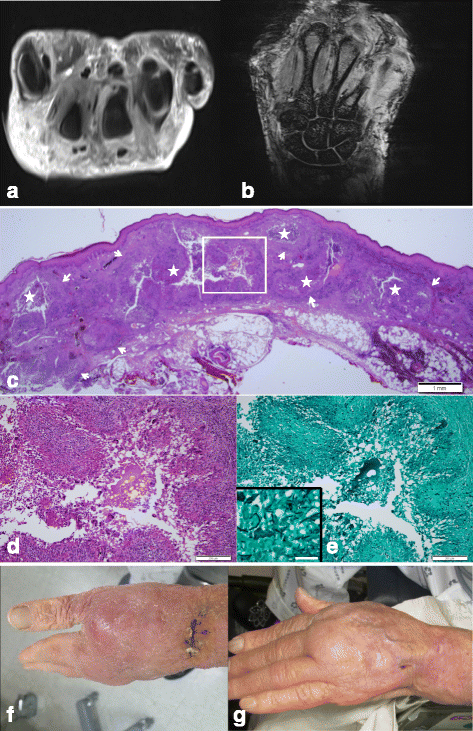Tenosynovitis caused by Scedosporium apiospermum infection misdiagnosed as an Alternaria species: a case report
- PMID: 28088169
- PMCID: PMC5237512
- DOI: 10.1186/s12879-016-2098-6
Tenosynovitis caused by Scedosporium apiospermum infection misdiagnosed as an Alternaria species: a case report
Abstract
Background: Scedosporium apiospermum, which can usually be isolated from soil, polluted stream water and decaying vegetation, is increasingly recognized as an opportunistic dematiaceous fungus. The mortality rate of infection in immunocompromised hosts is over 50%. S. apiospermum is commonly responsible for dermal and epidermal infections (i.e., mycetoma) after traumatic penetration.
Case presentation: A 73-year-old woman was admitted to our hospital complaining of painful swelling and tenderness on the dorsum of the proximal left wrist and hand. The symptoms had persisted for approximately 2 months. A physical examination revealed a 4 x 3 cm, poorly defined, erythematous papule, which was fluctuant, with pustules and crusts on the dorsum of the left hand.
Conclusions: We report a very rare case of tenosynovitis caused by S. apiospermum infection. We identified the infectious agent via molecular DNA sequencing. The infectious agent was initially misidentified as an Alternaria species by microscopic examination with lactophenol cotton blue (LPCB) staining. The infection was successfully treated with debridement and adjuvant fluconazole therapy.
Keywords: Case report; Debridement; Scedospermum apiospermum; Tenosynovitis.
Figures

Similar articles
-
Recurrent Scedosporium apiospermum mycetoma successfully treated by surgical excision and terbinafine treatment: a case report and review of the literature.Ann Clin Microbiol Antimicrob. 2017 Apr 14;16(1):31. doi: 10.1186/s12941-017-0195-z. Ann Clin Microbiol Antimicrob. 2017. PMID: 28410611 Free PMC article.
-
Scedosporium apiospermum infectious scleritis following posterior subtenon triamcinolone acetonide injection: a case report and literature review.BMC Ophthalmol. 2018 Feb 13;18(1):40. doi: 10.1186/s12886-018-0707-4. BMC Ophthalmol. 2018. PMID: 29433463 Free PMC article. Review.
-
A Rare Diagnosis: Recognizing and Managing Fungal Tenosynovitis of the Hand and Upper Extremity.J Hand Surg Am. 2017 Feb;42(2):e77-e89. doi: 10.1016/j.jhsa.2016.11.014. Epub 2016 Dec 20. J Hand Surg Am. 2017. PMID: 28011032
-
[The Importance of Mycological Diagnosis: A Scedosporium apiospermum Complex Mycetoma Case Neglected For 20 Years].Mikrobiyol Bul. 2021 Apr;55(2):256-264. doi: 10.5578/mb.20219911. Mikrobiyol Bul. 2021. PMID: 33882656 Turkish.
-
A systemic infection involved in lung, brain and spine caused by Scedosporium apiospermum species complex after near-drowning: a case report and literature review.BMC Infect Dis. 2024 Mar 21;24(1):342. doi: 10.1186/s12879-023-08279-9. BMC Infect Dis. 2024. PMID: 38515075 Free PMC article. Review.
Cited by
-
Scedosporiosis and lomentosporiosis: modern perspectives on these difficult-to-treat rare mold infections.Clin Microbiol Rev. 2024 Jun 13;37(2):e0000423. doi: 10.1128/cmr.00004-23. Epub 2024 Mar 29. Clin Microbiol Rev. 2024. PMID: 38551323 Free PMC article. Review.
-
Deep Fungal Infections of the Upper Extremity - A Review.Orthop Rev (Pavia). 2024 Mar 9;16:94570. doi: 10.52965/001c.94570. eCollection 2024. Orthop Rev (Pavia). 2024. PMID: 38469579 Free PMC article.
-
Multi-organ involvement caused by Scedosporium apiospermum infection after near drowning: a case report and literature review.BMC Neurol. 2024 Apr 15;24(1):124. doi: 10.1186/s12883-024-03637-9. BMC Neurol. 2024. PMID: 38616262 Free PMC article. Review.
References
-
- Husain S, Muñoz P, Forrest G, Alexander BD, Somani J, Brennan K, et al. Infections due to Scedosporium apiospermum and Scedosporium prolificans in transplant recipients: clinical characteristics and impact of antifungal agent therapy on outcome. Clin Infect Dis. 2005;40:89–99. doi: 10.1086/426445. - DOI - PubMed
-
- Castiglioni B, Sutton DA, Rinaldi MG, Fung J, Kusne S. Pseudallescheria boydii (anamorph Scedosporium apiospermum). Infection in solid organ transplant recipients in a tertiary medical center and review of the literature. Medicine. 2002;81:333–48. doi: 10.1097/00005792-200209000-00001. - DOI - PubMed
Publication types
MeSH terms
Substances
LinkOut - more resources
Full Text Sources
Other Literature Sources
Medical

